The Samsung Galaxy Tab S2 Review
by Brandon Chester on October 15, 2015 8:00 AM ESTDisplay Analysis
Before getting into our typical display analysis, I wanted to address a question that I'm sure some people have. A quick examination of a Tab S2 8.0's subpixel arrangement confirms that the smaller model uses a PenTile subpixel arrangement, and there's significant artifacting on the edges of icons and text, with the issue being very pronounced with thin weighted fonts. This is a big disappointment for users who prefer small tablets, and I would almost hesitate to recommend the smaller model for that reason alone because of how prevalent the issue is.
While the smaller model of the Tab S2 uses diamond PenTile, the Tab S2 9.7" does use an RGB-like subpixel arrangement, and it's essentially the same as the one used on the original Tab S 10.5. In practice there aren't really any artifacts as a result of the subpixels not being lined up exactly like a conventional LCD display, and it looks every bit as sharp as the iPad Air 2 which is exactly what I had hoped for.
To test the various attributes of the Tab S2 9.7's display I've run it through out standard display workflow. All measurements are done with an X-Rite i1Pro 2 spectrophotometer, and in the case of LCD devices the contrast measurements are done with an i1Display Pro colorimeter. SpectraCal's CalMAN 5 software is used for measuring and collecting data, and for generating graphs that are relatively easy to understand.
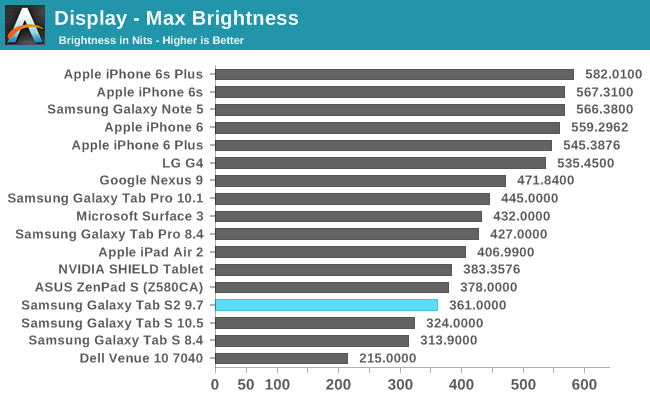
The Average Picture Level (APL) of an image can be thought of as a percentage expressing the luminance relative to a 100% white display. Since AMOLED displays target a given power consumption but can save power by turning off black pixels they can push a higher maximum brightness when the display's APL is low. Above you can see how the maximum brightness of white scales with average picture level. Real world use cases tend to be somewhere around 80% APL, and while there are always exceptions, this trend has continued with Google's new guidelines for designing Material Design applications. What's important about this chart is it shows that in most scenarios the Tab S2 9.7 actually isn't any dimmer than a tablet like the iPad Air 2, and much brighter than the original Tab S.
As for contrast, there's no point in displaying a chart, as Samsung's AMOLED displays can simply shut off pixels and achieve infinite contrast and true blacks. There's really nothing that comes close on any LCD-based tablet, and the true blacks of AMOLED displays simply become even more stunning as you scale up from a phone to a tablet, and again from a tablet to a television.
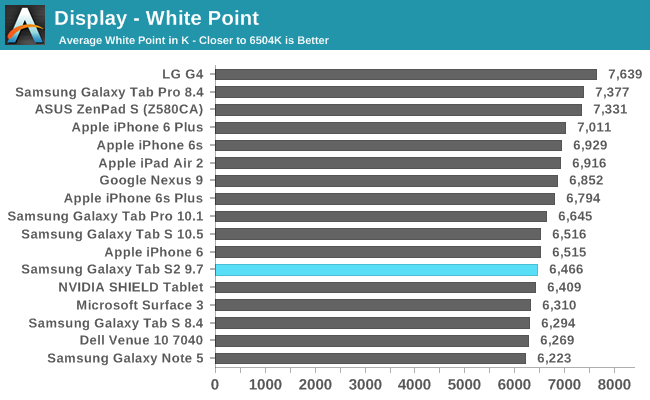
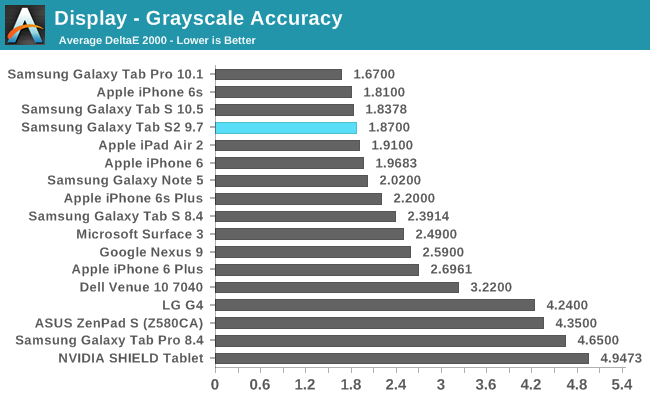
Samsung's AMOLED calibration has improved tremedously in recent years, and the Tab S2 9.7 is no exception. The greyscale has a very high level of accuracy, with very low errors across the board. When you move past 70% white there is a degree of green tinting to whites and greys that appears, and this is noticeable during general use. I did find it to be somewhat bothersome, but I think this is mostly due to the fact that I test and use many different devices regularly. If the Tab S2 9.7 was my only tablet I would be perfectly happy with the level of calibration, and I would get used to the good but not perfect calibration when shades approach 100% white.
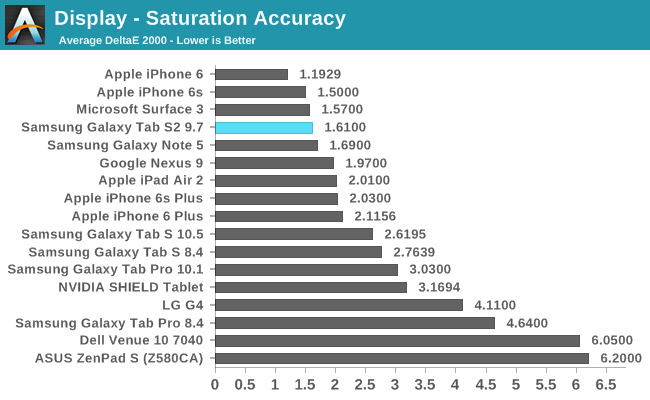
Saturation accuracy on the Tab S2 9.7 is phenomenal. It's better than every other tablet except for the Microsoft Surface 3, and at this point you would really be hard pressed to see errors in the rendering of pure primary and secondary colors. Most of the errors seem to be at the very extreme 100% saturations, and in daily use I never felt like the appearance of colors was off in any way.
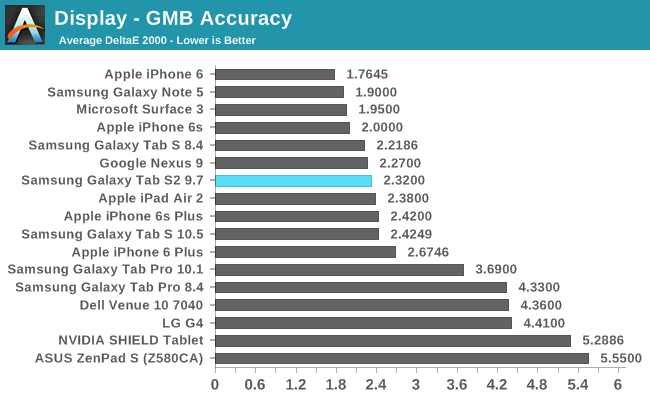
In the Gretag-Macbeth ColorChecker test we again see a very high level of color accuracy on the Tab S2 9.7. The biggest contribution to errors are actually the grey shades that are tested, along with some slight errors in red and blue based color mixtures. To criticize these results would honestly be pedantry, as unless your tablet workflow involves editing videos and photos with absolutely no visible color errors the Tab S2 9.7 provides a more than sufficient level of accuracy.
There's really not much else to say about the Tab S2 9.7's display. Samsung has really done a great job with calibrating the displays on recent AMOLED devices, and the Tab S2 9.7 offers a display that is just as good as any other tablet. One could argue that the true blacks actually put the Tab S2 9.7 ahead of the competition, and I would be inclined to agree. My only complaint is that the iPad Air 2 with its AR coating tends to be a bit more usable outside and in other scenarios where there are heavy reflections. There's really no way to conclude which tablet offers the absolute best display, but I think it would be correct to say that in most cases the Tab S2 9.7's display is as good, if not better than any other tablet on the market.


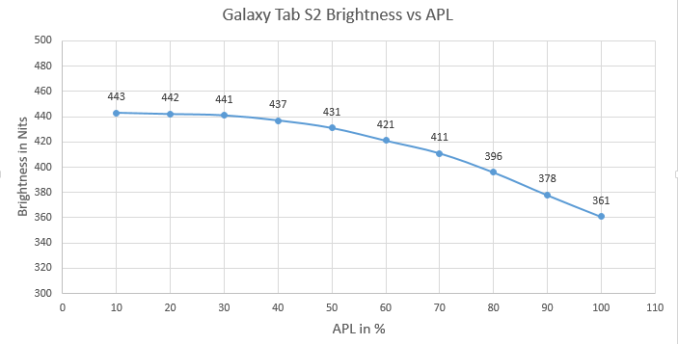
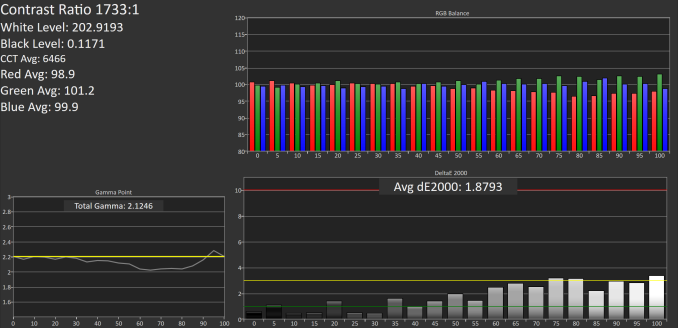

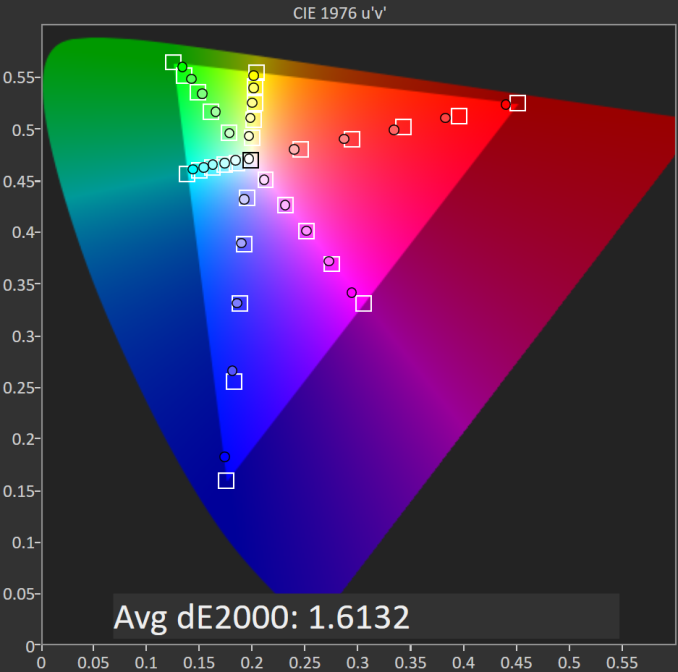










162 Comments
View All Comments
theduckofdeath - Sunday, October 18, 2015 - link
Because tablets really, really benefit from every mm or gram lost. It's not rocket science.nathanddrews - Thursday, October 15, 2015 - link
For $500, I'd rather just get a Surface 3...lilmoe - Thursday, October 15, 2015 - link
+1That would be my only choice for that price range. But the Surface Pro 3 is on sale for ~$630, so I'd go for that.
lilmoe - Thursday, October 15, 2015 - link
Also, for the extra ~$100 in cost (plus ~100 for the type cover), you're getting a device that will easily outperform any ARM tablet in performance, and outlast them in OS/software support. You won't have to worry about planned obsolescence in performance and support either.If Microsoft releases a 10" Surface 4 (non-pro) with a Core M3/M5, it would be the perfect tablet in its class, even if it still had the same resolution (1920x1280).
Alexey291 - Thursday, October 15, 2015 - link
Instead you have to worry about using Windows. I'm sorry but the last thing I want in my dedicated browsing device / content consumption device is having bsods (yup they still happen) or viruses/trojans.Let alone the rest of Windows bullshit which is the prime reason why so many people got arm tablets in the first place. To get away from Windows.
steven75 - Thursday, October 15, 2015 - link
Yep, the problem with the Surface is Windows. The hardware is mostly fine.wavetrex - Thursday, October 15, 2015 - link
Can you install Linux on Surface ? :)That would be fun... MICROSOFT Surface, Powered by LINUX :)
thedons1983 - Saturday, October 17, 2015 - link
Linux is shit! Anyone that uses it, has a penchant for pain and suffering...thedons1983 - Saturday, October 17, 2015 - link
And what OS what you replace it with exactly? iOS is shit, as is OS X. Linux is crap, Android isn't a fully fledged OS... So what are you using, that's so great??lilmoe - Thursday, October 15, 2015 - link
Windows is a plus. Windows was never a downside except for those "YES", "OK", "Go Ahead and Install" (because you won the lottery) go happy pop-up clickers.Let's be honest here, those who use ARM tablets for anything other than browsing and watching youtube are a very small minority.